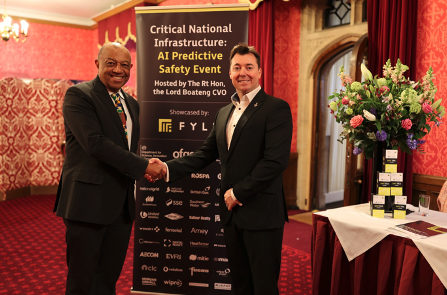
In an exclusive event held within the historic walls of the Palace of Westminster, London, The Rt Hon. The Lord Boateng CVO, a 40-year veteran of Parliament, brought together a distinguished assembly of government officials and executive leaders from across the UK’s Critical National Infrastructure sectors. Held on Thursday, 6th February, this high-profile meeting shone a spotlight on the groundbreaking advancements in Predictive Safety through Artificial Intelligence (AI), an innovation poised to redefine risk mitigation across the nation’s infrastructure.
The Future of Predictive Safety with AI
At the helm of this transformative event was Karl Simons OBE, Chief Futurist and Co-Founder of FYLD, an AI technology company pioneering predictive risk intelligence. Joined by government and industry leaders, the event delved deep into the real-world application of AI in ensuring the safety and resilience of essential services, including energy, transportation, rail, water, and telecommunications.
A major highlight of the gathering was the presentation of outcomes from the UK Energy Regulator Ofgem’s visionary ‘AI Predictive Safety Interventions’ programme. This initiative, a two-year government-backed investment programme, had been developed by FYLD in partnership with Scotia Gas Networks, Cadent Gas, Northern Gas Networks, National Gas, and National Grid. By leveraging AI, this programme successfully anticipated potential risks, allowing proactive safety measures to be taken before and during infrastructure works. The results demonstrated a significant enhancement in risk intelligence, driving critical improvements in safety protocols, operational efficiency, and quality assurance.
A Gathering of Industry Titans
The event hosted 65 executive leaders, including government officials from the Department for Science, Innovation and Technology, the Office of Energy Regulation and the Health & Safety Executive. National safety Institutions such as IOSH, NEBOSH, RoSPA and CITB were also in the room and from the Critical National Infrastructure sectors, Client organisations such as National Highways, National Grid, Network Rail, National Gas, British Gas, SSE, Scottish Power, SGN, Southern Water, Affinity Water, Vodafone, Heathrow and more. Additionally, the presence of Group Safety Directors from top national infrastructure contractors, including Colas, Balfour Beatty, Skanska, Kier, Ferrovial, MGroup, Morgan Sindall, Vinci, Amey, Mace, Mitie, Veolia, AECOM, and leading data centre operators Digital Realty and Equinix, underscored the widespread industry commitment to AI-driven safety transformation
The meticulously curated agenda ensured a comprehensive exploration of AI’s role in shaping the future of infrastructure safety. Key sessions included an insightful opening address by The Rt Hon. The Lord Boateng CVO, highlighting the strategic importance of collaborating on AI in securing the nation’s critical infrastructure. This was followed by an AI Predictive Safety Interventions presentation led by Scott Broadley, Chief Customer Officer & Solutions Architect at FYLD, showcasing the tangible impact of AI-driven risk prediction. A panel discussion on Regulation, Engagement & Accountability featured senior industry figures such as Shelley Copsey (FYLD CEO), Jane Lassey (Director of Regulation, Health & Safety Executive), and Benjamin Legg (Global VP H&S, Digital Realty), who discussed the regulatory and ethical dimensions of AI in safety management.
Karl Simons stated, “The advancements showcased at this event illustrate the immense potential of AI in not just identifying risks but actively preventing incidents before they occur. By integrating predictive analytics into infrastructure operations, organisations significantly reduced workplace injuries, enhanced worker safety, and minimised disruptions to the public. With AI increasingly becoming a cornerstone of national infrastructure strategy, this gathering marks a pivotal moment in the evolution of occupational safety. The insights shared and collaborations formed here will undoubtedly shape the next phase of AI-driven safety innovations, ensuring that the UK remains at the forefront of technological excellence in infrastructure and worker protection.”




